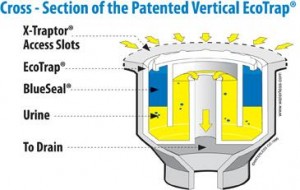Taking Toilets Waterless
- Share
- Tweet
- Pin
- Share
It sounds counterintuitive – and a little gross – when one is told about a waterless urinal, but improved technology is making “low-flush” passé when it comes to conserving water.
When Citi Field opened in Queens, NY this spring as the sparkling new home of the New York Mets, it cut its water use by installing 270 waterless urinals in all its men’s rooms. The urinals are estimated to save as much as 40,000 gallons of water per year in high-traffic venues like stadiums, office buildings, and government centers.
While the typical urinal uses water to flush urine away and control odor and bacteria, waterless urinals use a vegetable-based sealant that floats on top of water to lock in odor and gasses. Though the urinals look similar to a regular urinal, they don’t need a pipe for water intake. Models from companies like Waterless and Falcon use a cartridge filled with the sealant that is installed in the drain and must be replaced periodically. Kohler, however, has developed a line of waterless urinals that eliminates the need for a cartridge. The Wisconsin company instead uses a sealant that is poured into the drain that must be flushed out and replaced every couple of weeks.
The urinals cost between $300 and $1,000 depending on the model and company.
Mark Mahoney is a marketing representative for Kohler Co. He said the company is seeing greater interest in all manner of water-saving products.
“Water conservation is certainly a global issue,” he said. Builders in the Southeast and Southwest, where water is in short supply, are clamoring for water-saving technology. “Because of the shortage, some states in those regions are offering tax breaks and grants for conservation technology, and people are calling us to find out what’s available.”
The sealant for the Kohler models costs about $50 a jug, Mahoney said, and should get a user about 1,500 flushes for every three ounce application. Meanwhile, the cartridges for other models cost as little as $7 and must be replaced up to four times a year, according to Waterless.
In addition to saving water, facility managers save the cost of maintaining plumbing fixtures, water and sewer bills, and the enormous cost of treating and transporting all that fresh water just to flush human waste. One estimate puts the CO2 savings from not pumping and transporting water at 18 million pounds of CO2 for every billion gallons of water saved.
So next time your local government announces plans to build a new facility or public restroom, ask if they’ve looked into going waterless.


